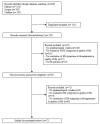The Burden of Hidradenitis Suppurativa Signs and Symptoms in Quality of Life: Systematic Review and Meta-Analysis
- PMID: 34206415
- PMCID: PMC8293810
- DOI: 10.3390/ijerph18136709
The Burden of Hidradenitis Suppurativa Signs and Symptoms in Quality of Life: Systematic Review and Meta-Analysis
Abstract
Hidradenitis suppurativa (HS) is a chronic, recurrent and debilitating inflammatory skin disease of the hair follicle that usually presents as painful, deep-seated inflamed lesions in the apocrine gland-bearing areas of the body. HS patients suffer from uncomfortable signs and symptoms, such as pain, pruritus, malodour and suppuration, which may impair patients' quality of life (QoL). Although HS patients frequently experience these signs and symptoms, they are only occasionally assessed by clinicians and, unexpectedly, the scientific evidence available is limited and heterogeneous. The aim of this study is to summarize the evidence regarding the impact of HS signs and symptoms on QoL to serve as a basis for future research and help clinicians to consider them in the daily care of HS patients. A systematic review and meta-analysis were conducted following PRISMA Guidelines. The following search algorithm was used: (hidradenitis or "acne inversa") and (pain or itch or odour or malodour or suppuration or oozing or drainage) and ("quality of life"). The literature search identified 836 references, 17 of them met the eligible criteria and were included for analysis, representing 4929 HS patients. Mean age of the participants was 36.28 years and there was a predominance of female sex among study participants. The BMI of the population was in the range of over-weight and about two out five patients were active smokers. Studies included patients with mild to moderate HS, with a mean disease duration of 13.69 years. The HS signs and symptoms assessed were pain, pruritus, malodour and suppuration. Overall, the higher intensity of a sign or symptom correlated with poorer general QoL or specific QoL dimensions including sexual distress, anxiety, depression and sleep. The most frequently employed tool to assess QoL was the Dermatology Life Quality Index (DLQI). DLQI was used in 52.9% of the studies (9/17) with a mean value of 10.70 (2.16 SD). The scores employed to assess signs and symptoms severity were subjective and varied between studies, being the numerical rating scale (NRS) for each of the most used symptoms. The mean NRS value for pain was 3.99 and the mean NRS for pruritus was 4.99. In conclusion, we have summarized, categorized and analyzed the scientific evidence regarding signs and symptoms in HS patients and their impairment in QoL. Their assessment should be thorough and included during routine evaluation of HS patients to motivate therapeutic modifications and increase patients' health.
Keywords: acne inversa; dermatology; hidradenitis suppurativa; pain; pruritus; quality of life.
Conflict of interest statement
The authors declare no conflict of interest.
Figures




References
-
- Orenstein L.A.V., Nguyen T.V., Damiani G., Sayed C., Jemec G.B.E., Hamzavi I. Medical and Surgical Management of Hidradenitis Suppurativa: A Review of International Treatment Guidelines and Implementation in General Dermatology Practice. Dermatology. 2020;236:393–412. doi: 10.1159/000507323. - DOI - PMC - PubMed
-
- Zouboulis C.C., Bechara F.G., Dickinson-Blok J.L., Gulliver W., Horvath B., Hughes R., Kimball A.B., Kirby B., Martorell A., Podda M., et al. Hidradenitis suppurativa/acne inversa: A practical framework for treatment optimization-systematic review and recommendations from the HS ALLIANCE working group. J. Eur. Acad. Dermatol. Venereol. 2019;33:19–31. doi: 10.1111/jdv.15233. - DOI - PMC - PubMed
Publication types
MeSH terms
LinkOut - more resources
Full Text Sources
Medical
Research Materials
Miscellaneous

